ISSN ONLINE(2319-8753)PRINT(2347-6710)
ISSN ONLINE(2319-8753)PRINT(2347-6710)
Sudarsana Rao hunchate1, Giridhar Valikala2, Vaishali. G. Ghorpade 3
|
| Related article at Pubmed, Scholar Google |
Visit for more related articles at International Journal of Innovative Research in Science, Engineering and Technology
The Present paper investigates the influence of water absorption of ceramic waste aggregate on strength properties of ceramic aggregate concrete. Compressive strength and split tensile strength of concrete made with ceramic waste aggregate is studied with replacement of natural coarse aggregate by ceramic waste aggregate at 0%, 20%, 40%, 60%, 80% and 100%. Due to the influence of water absorption and external porcelain nature, strength of ceramic concrete is declining gradually but strength of ceramic concrete is more than the targeted mean strength even after replacing 100% of natural coarse aggregate.
Keywords |
| Ceramic waste aggregate, Ceramic aggregate concrete, water absorption, Compressive strength, Tensile strength. |
INTRODUCTION |
| In modern way of construction, the consumption of ceramic materials has building up day by day in the form of tiles, sanitary fittings and other electrical goods like insulators. Crushed Insulator bush scrap was used as a coarse aggregate in the present study. This insulator bush was used in manufacturing of transformers. This type of Ceramic waste from industries is mounting day by day in processing, transporting and fixing due to its brittle nature. It is reported that toughness and soundness of recycled coarse aggregate is 30% less than the natural aggregate and loss of strength is about 30% as compared to the conventional aggregate concrete. Similar trends were reported even for split tensile strength also [1]. Reduction of slump was 5.3% when recycled ceramic aggregate was used at a replacement level of 25% and its water absorption was 0.55%, which was higher than that of natural aggregate at 0.23% [2]. Compressive strength of concrete made with ceramic insulator and glass concrete was 16% and 26.34% lower as compared to the conventional concrete [3]. Recycled aggregate shows higher water absorption and lower density due to the mortar adhered to the recycled aggregate and these characteristics influenced the compressive strength and modulus of elasticity [4]. Due to its pore structure, ceramic aggregate shows lower water absorption (0.72%) as compared to natural aggregate (1.2%) and as the permeation characteristics values increases with increase of water-cement ratio [5]. Maximum reduction of compressive strength of 12.2% and 36.1% of split tensile strength were observed @ 800oc fired temperature for waste ceramic aggregate in concrete [6]. Addition of tile granules in ceramic concrete, decreases the compressive strength and increases the water absorption due to polishing powder [7]. Workability of concrete with ceramic waste aggregate decreases with increase of ceramic waste aggregate, compressive strength slightly drops with 100% substitution [8]. Strength of concrete increases due to replacing fine aggregate with stone dust and declined with the replacing of coarse aggregate with ceramic scrap [9]. Concrete produced with coarse recycled aggregate had shown lower compressive strength of about 28% and better results were obtained when fine aggregate is replaced with ceramic powder [10]. Replacing recycled brick bats as coarse aggregate in concrete, there was a reduction of concrete strength properties [11]. Replacement of traditional coarse aggregate by ceramic coarse aggregate, the results are promising but under performed slightly in water absorption [12]. Concrete mixes containing recycled ceramic aggregate achieved the strength levels of 80% to 95% as compared to normal conventional concrete [13]. Ceramic aggregates show higher water absorption than limestone aggregate. The mechanical properties of ceramic concrete decreases with increasing of replacement of ceramic aggregate (Hollow clay brick) [14]. The compressive, split tensile and flexural strengths are lowered by 3.8%, 18.2%, and 6% as ceramic waste was used as coarse aggregate [15]. Fig.1 show the crushed ceramic waste obtained from the insulator porcelain ceramic bush and scrap dump shown in Fig. 2 which is used in this study. |
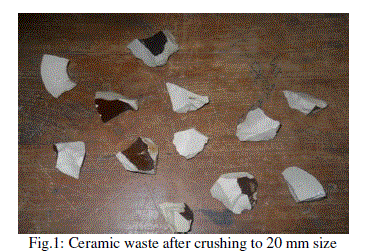 |
II. EXPERIMENTAL PROGRAM |
| Experimentation was done for verdict of following |
| A. Water absorption of ceramic waste aggregate and crushed natural aggregate. |
| B. Effect of water absorption of Ceramic waste aggregate on strength parameters like compressive strength and Split tensile strength. |
III MATERIALS USED IN EXPERIMENTATION |
| A. Cement: |
| 53 Grade ordinary Portland cement of DALMIA make conforming to IS 12269 was used. The Specific gravity of the cement was 3.05. The initial and final setting times were found as 80 minutes and 280 minutes respectively. |
| B Fine aggregate: |
| Locally available river (From Pennar basin at Kadapa) sand passing through 4.75 mm IS Sieve was used. The specific gravity of the sand is found as 2.62 and confirming to zone II of table 4 of IS 383-1970. |
| C. Natural Coarse aggregate: |
| Crushed granite aggregate available from local sources near Ramapuram in Kadapa district has been used. The size of coarse aggregate is 20mm.The specific gravity of the aggregate is 2.68. |
| D. Ceramic waste aggregate: |
| Ceramic waste was collected from manufactures of electric Transformers, in which ceramic insulator bushes are used. Crushing of these bushes was done manually and made it into 20 mm and 12.5 mm size of aggregates. Centre part of these bushes has 20 mm thickness. Deglazing of ceramic waste was done with chiseling and crushing. |
| E. Water: |
| Potable water available from local sources was used for mixing and curing of specimens. |
IV. MIX PROPORTION |
| Based on the ingredient properties of concrete, M20 concrete mix design as per IS 10262-1982 was prepared and its proportion was 0.48: 1: 1.53: 2.88 (W: C: FA: CA) by weight. For better workability, graded aggregates were used as 60 % of 20 mm and 40 % of 12.5mm. |
V. TEST PROCEDURE |
| A. Water absorption: |
| Water absorption test was performed on both types of coarse aggregates by keeping the samples immersed in water and removing the excess water on surface of the samples after 24 hrs, and measuring the saturated weight. After that the samples were kept in oven by maintaining 100 ±5°C for one day. Oven dry weight of the samples is recorded and the water absorption is evaluated. |
| B. Compressive strength: |
| Six cube specimens for each replacement percentage were cast according to the design mix. The size of cubes is 150x150x150mm. To study the workability, slump cone test and compaction factor tests were performed. Specimens were compacted in table vibrator and de-molded after 24 hrs and cured in water pond @ temperature of 27 ±2° for a period of 28days. After completion of curing period, specimens were removed from pond, kept for drying and then tested in compression testing machine of 2000 KN Capacity. |
| C. Split tensile strength |
| Six cylindrical specimens for each replacement percentage were cast according to the design mix. The cylindrical specimens are of 150mm diameter and 300mm height. Specimens were de-molded after 24 hrs and cured into pond @ temp of 27 ±2° for a period of 28 days. Split tensile strength is measured by testing cylinder under diametric compression. Based on the load at which the cylinder splits, the split tensile strength is computed. |
VI. RESULTS AND DISCUSSION |
| A. Water absorption: |
| Water absorption of ceramic waste was 0.18% and that of natural aggregate was 0.10%. Higher water absorption is observed for ceramic aggregate because of surface area, pore structure and clay content. Ceramic aggregate has crystalline structure. The pore structure is compacted and even crushing of these will not wide opens. So, due to this reason water absorption has increased little in ceramic scrap. Ceramic scrap has porcelain cover over the top surface, deglazing was done partially during chiseling and crushing. Partial deglazing of ceramic waste surface is influencing the water absorption property (see Fig 3&4). Table no 1 presents the comparison of physical properties of ceramic waste aggregate and crushed granite coarse aggregate. All the properties were well within the acceptable range for coarse aggregates and hence the ceramic waste aggregate can be safely used in concrete making. |
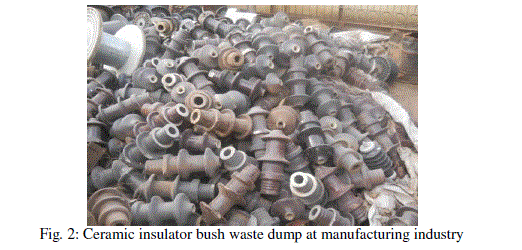 |
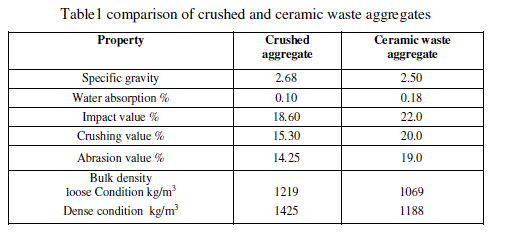 |
| B. Compressive strength: |
| Compressive strength of ceramic waste aggregate concrete was 32.15 MPa at 100% replacement level. Based on the results, the fall of compressive strength and density of concrete was gradual when the replacement increases. Even at 100% replacement, strength was declined to 13% only. Targeted strength crosses even with 100% replacement with ceramic aggregate also. Compressive strength decreases due to increase of replacement of ceramic coarse aggregate. Water absorption of ceramic aggregate is higher as 0.18% than the natural aggregate as 0.10%. For the same water cement ratio, more quantity of water is absorbed by ceramic aggregate meant for workability. This causes improper bonding in the interfacial transition zone and hence the compressive strength decreases. Strength values were gradually decreased, because of higher water absorption, adhered bonding between mortar paste and porcelain surface area and higher content of flaky aggregate (see Fig. 5). Due to more water absorption, dense state of concrete observed during the casting. |
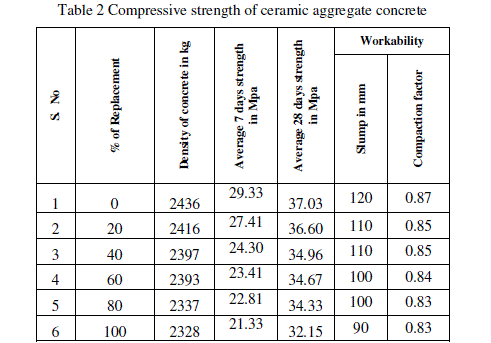 |
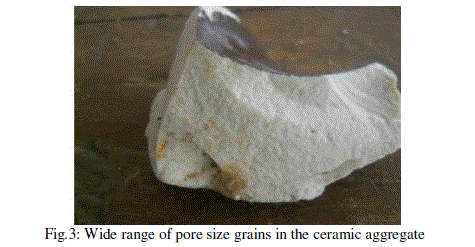 |
| C. Split tensile strength |
| Trends similar to that of compressive strength have been observed for split tensile strength also. With the increase of replacement of natural aggregate with ceramic waste aggregate increases, decrease in values of split tensile strength is noted (see Fig. 6). At 100% replacement level, split tensile strength is lowered by 23 % for 7 days and 30% for 28 days as compared to the conventional aggregate concrete. Tensile strength decrease may again be due to water absorption of ceramic waste aggregate and adhered bonding between porcelain surfaces. |
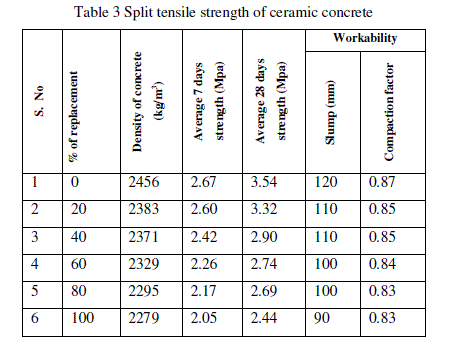 |
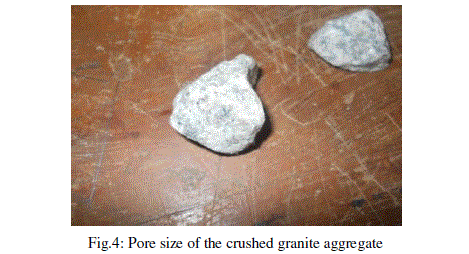 |
VII CONCLUSIONS |
| Following conclusions are drawn based on test results. |
| Natural granite coarse aggregate in concrete can be replace with ceramic waste aggregate as its properties are well within the range of specifications. Strength of ceramic concrete decreases due to many reasons such as higher flakiness, improper bonding of the aggregate with cement paste due to porcelain surface and higher water absorption of the ceramic waste aggregate. Observing the above results, strength aspects of ceramic waste aggregate concrete is well within the permissible limits and ideal replacement level of ceramic waste is 20% and 40%.Water absorption of ceramic waste aggregate was 0.18% higher than that of natural aggregate (0.10%), due to the opening of pore structure during crushing and chiseling. Even after crushing and chiseling, few cracks were observed on surface of ceramic waste. For these reasons water absorption was little more than that of the natural aggregate. Both compressive and split tensile strengths decrease as the quantity of ceramic waste aggregate increases. |
ACKNOWLEDGEMENT |
| The authors acknowledge the support of Management, Director, Principal and Head of Civil Engg dept of K.S.R.M College of Engineering and for providing the new equipment for experimentation work. |
References |
|